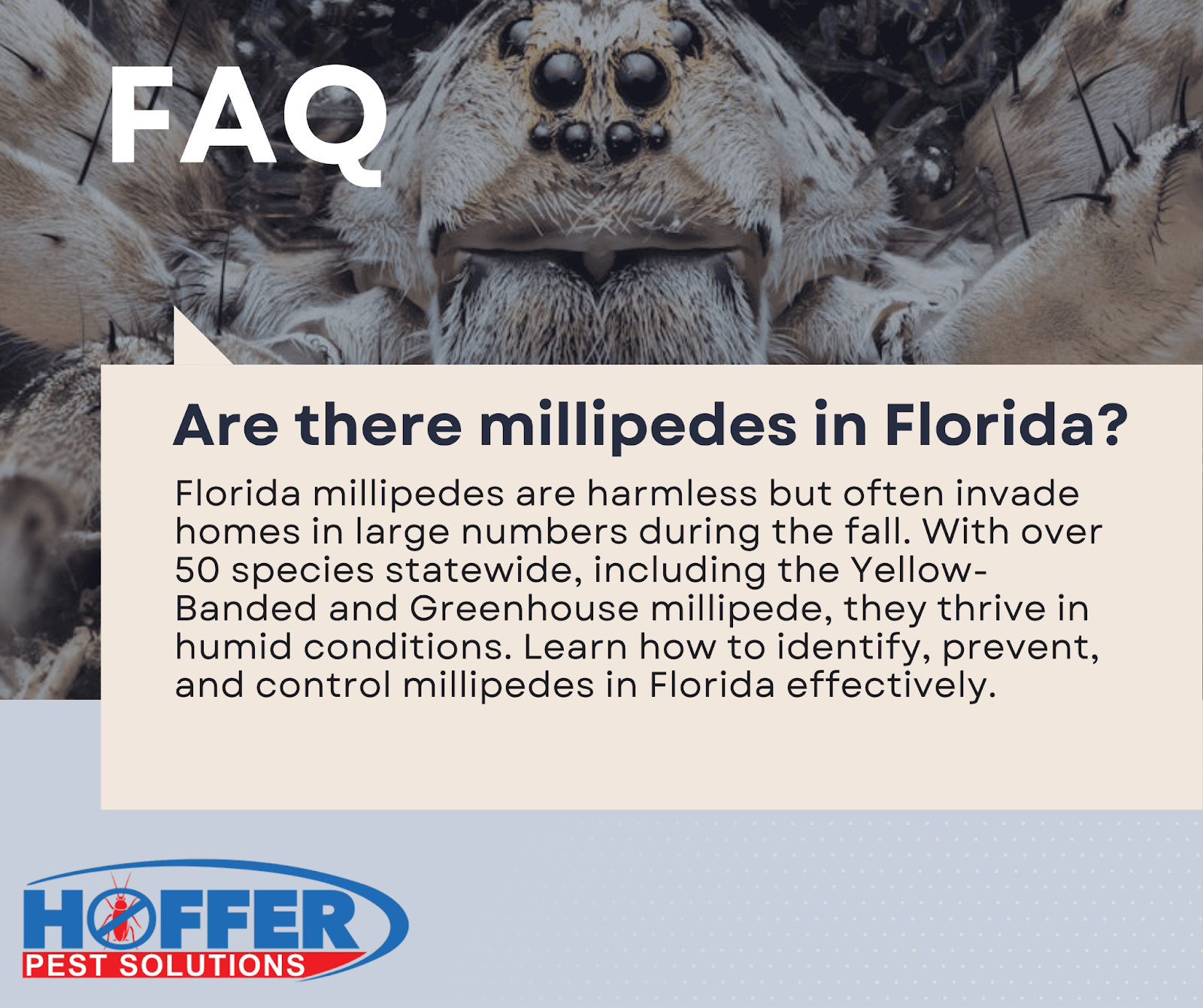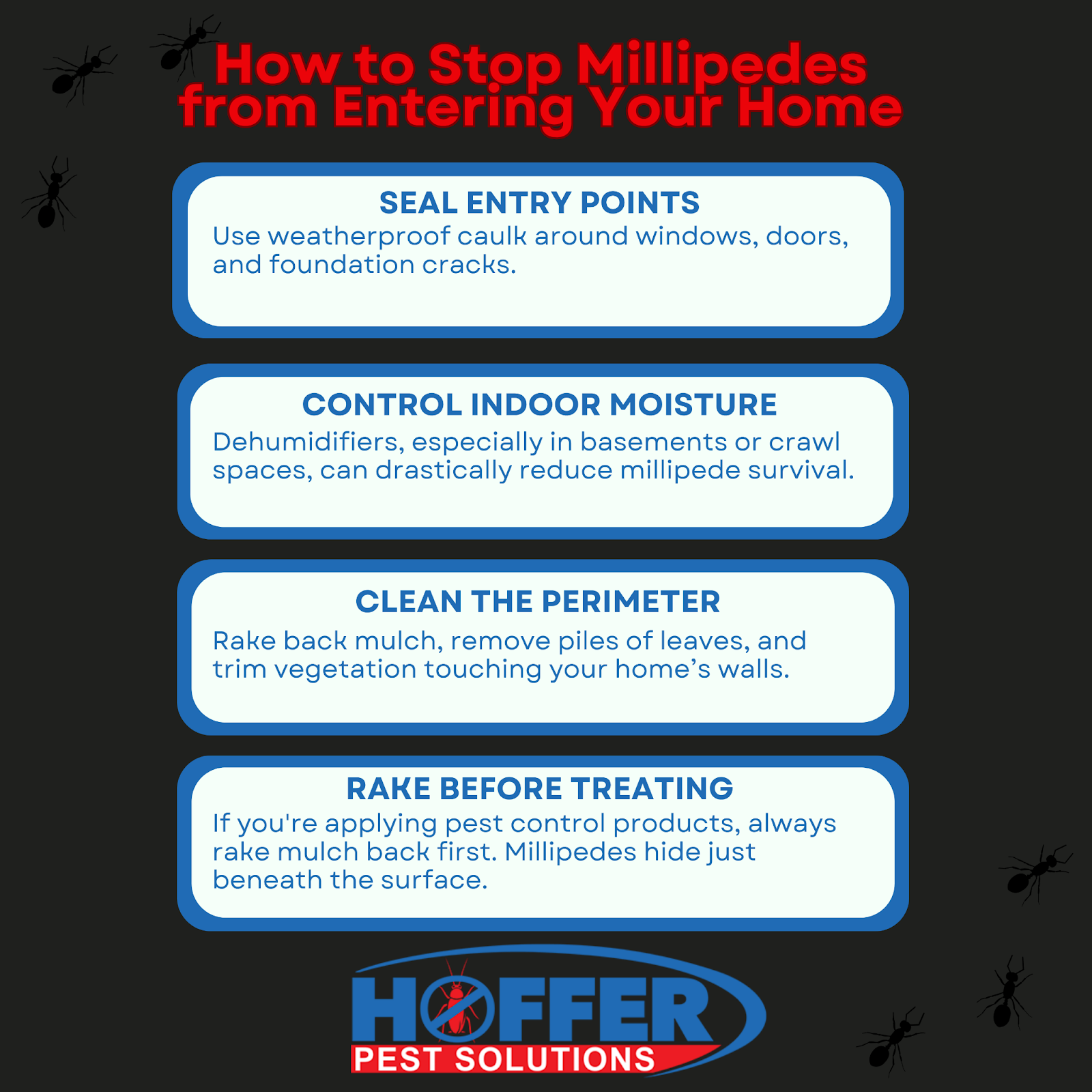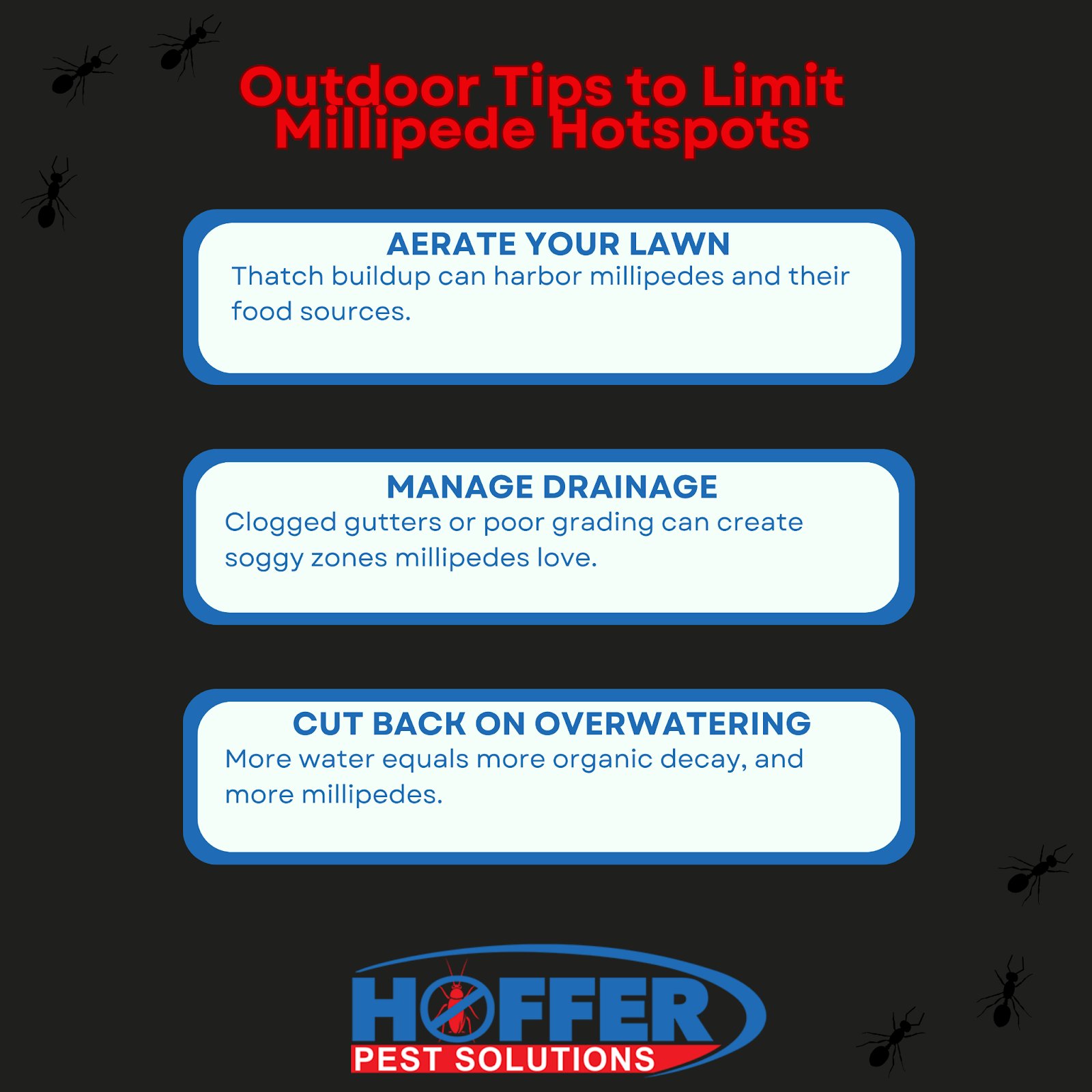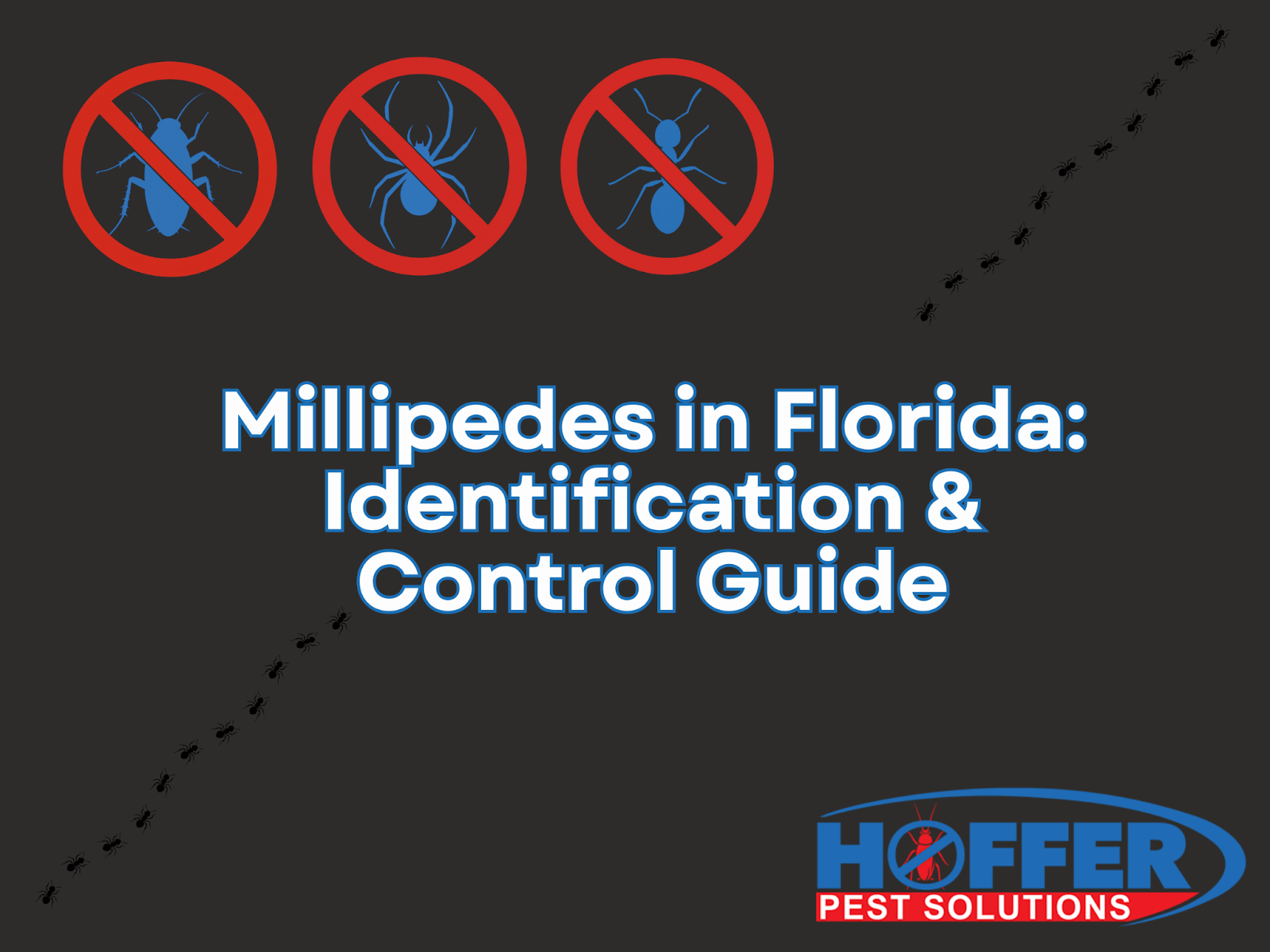Florida millipedes are harmless but often invade homes in large numbers during the fall. With over 50 species statewide, including the Yellow-Banded and Greenhouse millipede, they thrive in humid conditions. Learn how to identify, prevent, and control millipedes in Florida effectively.

These arthropods aren’t out to harm you, but their sudden appearance on your patio, driveway, or even inside your home can be unsettling. They often show up after heavy rain or seasonal shifts, especially in areas with fresh mulch, dense vegetation, or structural gaps.
Hoffer Pest Solutions help South Florida residents handle pest problems others don’t fully understand. Our team knows the local species, where they hide, and how to stop them from turning your home into a habitat.
Below, we’ll show you how to tell a millipede from a centipede, why they appear seemingly overnight, and what you can do to stop them, for good.
Florida’s Millipede Problem Explained
Here in Florida, we’re used to battling pests that thrive in our humid climate, but few are as misunderstood as the millipede. These long, leggy arthropods often take unsuspecting homeowners by surprise, especially when they arrive in droves during seasonal migrations.
Florida hosts more than 50 different millipede species. The good news? Most of them are harmless. The not-so-good news? A few, particularly the flat-backed and yellow-banded varieties, can invade homes and structures in large numbers during specific times of the year, especially after rain or during the fall season.
These mass appearances might look like an infestation, but they’re usually temporary. Millipedes are drawn out of their natural habitats when conditions become too moist or too dry. Their goal is to escape the saturated ground. Unfortunately, your living room just happens to be in the way.
How to Identify a Florida Millipede
Millipedes are often mistaken for insects, or worse, centipedes, but they’re a class of arthropod all their own. Here’s how to tell them apart:
Body Shape: Millipedes have a long, cylindrical body with a rounded head. Their segments are uniform and compact.
Legs: Each body segment bears two pairs of legs, giving them that characteristic “many-legged” appearance.
Antennae: Short and stubby, unlike the longer, whip-like antennae of centipedes.
Defensive Behavior: When threatened, millipedes curl tightly into a spiral, protecting their soft underbelly and delicate legs.
Coloration: Most Florida millipedes are brown or black, but some, like the Yellow-Banded Millipede, are more colorful with distinct stripes or markings.
It’s easy to confuse millipedes with centipedes or even caterpillars. Centipedes move faster and can bite. Caterpillars are softer, slower, and don’t have nearly as many legs. If you're unsure, look for the curl-up defense posture, that's a millipede's signature move.
What Kind of Millipedes Live in Florida?
While we see a wide range of species across Florida, a few frequent offenders stand out:
American Giant Millipede (Narceus americanus)
A chunky native species that rarely invades homes but often draws attention due to its size, up to four inches long.
Yellow-Banded Millipede (Anadenobolus monilicornis)
A non-native species that now thrives across Florida. These are often seen crawling across driveways and patios in large numbers.
Greenhouse Millipede (Oxidus gracilis)
Small and flat-backed, this millipede is notorious for entering homes through foundation cracks and door gaps.
Cyanide Millipede (Asiomorpha coarctata)
Similar to the Greenhouse millipede, this species gets its nickname from the hydrogen cyanide it releases as a defense mechanism.
Florida Ivory Millipede (Chicobolus spinigerus)
More docile and less likely to invade homes, though you may spot it wandering across roads or patios.
These species range in size from half an inch to over four inches, with coloration from earthy browns to bold yellow stripes. Some are easy to spot. Others sneak inside without warning.
Understanding Florida’s Millipede Migrations
Why do millipedes suddenly appear in droves on sidewalks, driveways, and occasionally in your kitchen? It all comes down to moisture, temperature shifts, and habitat disruption.
In Florida, millipede migrations usually peak during the fall, especially from September through November. After a heavy rain, saturated soil pushes millipedes out of their underground homes. Add in Florida’s naturally high humidity, and you’ve got the perfect recipe for mass movement.
You might also notice increased millipede activity if you've recently laid fresh mulch or made changes to your landscape. That disruption can drive them from their preferred habitat straight toward your home.
Millipedes are simply doing what they’ve done for millions of years, following moisture and seeking shelter.
Are Florida Millipedes Dangerous?
Millipedes aren’t venomous, don’t bite, and pose no actual health threat to humans or pets. However, some species do secrete a defensive fluid when stressed, which can irritate the skin or cause temporary discoloration, a condition some refer to as “millipede burn.”
This secretion isn’t harmful, but it can leave a lingering smell or skin stain that lasts several days. We’ve had customers call in worried after handling one bare-handed only to find a brown streak across their palm. The fluid, sometimes mildly acidic, is their only form of defense.
Millipedes are fragile, too. Drop one, and you may fatally crack its shell. That’s why handling them, especially for relocation, requires care.
Millipedes in Your Florida Home? Here’s What’s Really Happening
One of the biggest misconceptions we see is that millipedes “infest” homes. The truth is, they wander in accidentally, and then promptly die.
Unlike roaches or ants, millipedes cannot survive for long indoors. Without constant access to moisture, their bodies dry out in a matter of days. Most end up dead within 24–72 hours.
But if you’re seeing millipedes regularly indoors, it likely means two things:
There’s a moisture issue nearby: Leaky pipes, standing water, or poor ventilation may be creating the ideal microclimate.
There are too many outside: Large populations outside your home often lead to accidental intrusions indoors.
Fresh mulch, particularly around apartment complexes or commercial buildings, often correlates with indoor sightings. In one case, a welding shop reported dozens appearing after redoing their landscape beds.
And yes, millipedes can crawl up your walls. Their ability to scale flat, vertical surfaces takes many homeowners by surprise. If you see them at head-height on a stucco wall or window frame, that’s not a fluke, it’s a feature.
How to Stop Millipedes from Entering Your Home

The best defense is a strong perimeter. Here’s what we recommend:
Seal Entry Points: Use weatherproof caulk around windows, doors, and foundation cracks.
Control Indoor Moisture: Dehumidifiers, especially in basements or crawl spaces, can drastically reduce millipede survival.
Clean the Perimeter: Rake back mulch, remove piles of leaves, and trim vegetation touching your home’s walls.
Rake Before Treating: If you're applying pest control products, always rake mulch back first. Millipedes hide just beneath the surface.
These steps alone can cut down the number of intrusions dramatically. If you’re not sure where your vulnerabilities lie, Hoffer Pest Solutions offers home inspections that target exactly these types of pest entryways.
Outdoor Tips to Limit Millipede Hotspots

Beyond just blocking their entry, reduce what’s drawing them in to begin with:
Aerate Your Lawn: Thatch buildup can harbor millipedes and their food sources.
Manage Drainage: Clogged gutters or poor grading can create soggy zones millipedes love.
Cut Back on Overwatering: More water equals more organic decay, and more millipedes.
Our lawn and perimeter care programs help with this, ensuring your home isn’t acting like a five-star resort for moisture-loving pests.
Safe Handling Tips for Millipedes

If you do find yourself needing to remove one by hand, take the following precautions:
Use Gloves: Their defensive fluid can stain skin or irritate sensitive individuals.
Avoid Dropping: Millipedes are delicate. One short fall can be fatal.
Wash Immediately: If you do get sprayed, warm water and soap will help. Alcohol wipes can speed up the process.
And if your pet happens to sniff or nibble on one?
Don’t panic. While the secretion may taste foul and cause some drooling or mild stomach upset, it’s not toxic to dogs or cats in typical cases. Still, it’s a good idea to monitor them and call your vet if symptoms persist.
When to Call a Professional
You Don’t Have to Handle This Alone
Millipedes may not be dangerous, but when they start showing up inside your home by the dozens, or worse, hundreds. It’s frustrating and confusing. And it’s a clear sign that you need support.
We’ve been helping Florida families handle seasonal pest surges like millipedes for over four decades. What we bring to the table is not just effective pest control, it’s local expertise, trusted relationships, and solutions built around how Florida homes really work.
Millipede activity can indicate deeper issues like poor drainage, excess mulch buildup, or foundation vulnerabilities. These aren’t problems a can of bug spray will fix. That’s where professional help matters.
We know when millipedes are most likely to appear. We know where they hide. And we know how to keep them out, without disrupting your lifestyle or harming the environment in the process.
Why Hoffer Pest Solutions Is Florida’s Trusted Partner
There’s a reason families and businesses from Fort Lauderdale to Boca Raton choose Hoffer Pest Solutions over national chains and out-of-state providers.
Family-Owned & Operated: We’ve been part of the South Florida community for generations. This is where we live.
Specialized for Florida Pests: We understand how humidity, landscape, and construction styles all play a role in pest entry and activity.
Home Shield Protection Plans: Our recurring services don’t just manage millipedes, they cover the conditions that attract them.
Quick Response Times: In many cases, we offer same-day service so you don’t have to wait while pests make themselves comfortable.
Whether you're dealing with a sudden millipede migration or just want peace of mind before the next rainy season hits, we’ll create a personalized plan that protects your home from the ground up. Contact us for professional pest control.
Take Back Your Home from Millipedes
At the end of the day, millipedes are a part of life in Florida, but that doesn’t mean they have to be a part of your home.
If you’ve been finding these leggy invaders on your floors, walls, or patio furniture, it’s time to get answers and results. We treat the symptoms and also target the source, moisture zones, soil conditions, and structural entry points, to give you long-term relief.
Because protecting your home means making sure your family feels safe, your property stays clean, and your time can be spent on better things than cleaning up pests.
We believe in doing the job right, the first time, every time. Because we care about the same things you do: family, quality, and peace of mind.
Schedule your inspection today. Let’s reclaim your home, together.
Frequently Asked Questions (FAQ)
Why are they everywhere after rain?
Millipedes migrate to avoid overly saturated ground. Rain flushes them out.
Can I keep one as a pet?
Yes. Some Floridians even collect them. Just house them in a container with moist soil or mulch.
Why are they crawling up my apartment wall?
Their feet are designed to grip vertical surfaces, and they often follow gaps toward cooler or more humid zones.
Do they infest homes?
No. They can’t breed indoors or establish colonies. If one’s inside, it’s likely lost, and not for long.


